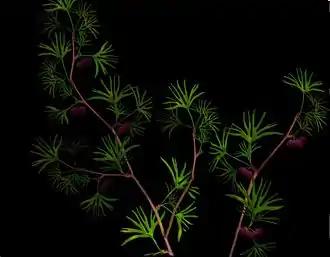Baiera
Baiera is a genus of prehistoric gymnosperms in the order Ginkgoales.[2] It is one of the oldest fossil foliage types of Ginkgoales,[3] and is related to the genera Ginkgo and Ginkgoites. Fossils of Baiera are found worldwide, and have been known from the Permian to the Cretaceous.
| Baiera Temporal range: Permian–Cretaceous | |
|---|---|
 | |
| Baiera gracilis fossil | |
| Scientific classification | |
| Kingdom: | Plantae |
| Clade: | Tracheophytes |
| Clade: | Gymnosperms |
| Division: | Ginkgophyta |
| Class: | Ginkgoopsida |
| Order: | Ginkgoales |
| Family: | Ginkgoaceae |
| Genus: | †Baiera Braun, 1843 |
| Species | |
|
†Baiera africana | |
Description

Baiera species are characterized by fan-shaped leaves,[4] are deeply lobed into four segments,[5] deeply incised into slender segments,[4] and are distinguished from Sphenobaiera by a petiole.[4]
B. africana is characterized by its symmetrical and triangular leaves.[6]
Classification
Karl Friedrich Wilhelm Braun first introduced the name Baiera in 1843 to refer to fossils in Germany that he interpreted as ginkgophytes.[7] In 1936, Carl Rudolf Florin used Baiera to refer to leaves with a distinct stalk or petiole and with a semicircular or triangular shape.[7]
Placement of Baiera
Gerd Dietl and Günter Schweigert (2011) place Baiera in the family Ginkgoaceae,[2] while a 2015 classification by Andriy Novikoff and Beata Barabasz-Krasny places it in the Karkeniaceae.[8][9]
References
- "Fossilworks: Baiera". fossilworks.org.
- "Fossilworks: Baiera". fossilworks.org. Retrieved 17 December 2021.
- Guignard, Gaëtan; Yang, Xiao-Ju; Wang, Yong-Dong (2019-09-01). "Cuticle ultrastructure of Baiera furcata from Northeast China and its implication in taxonomy and paleoenvironment". Review of Palaeobotany and Palynology. 268: 95–108. doi:10.1016/j.revpalbo.2019.05.006. ISSN 0034-6667. S2CID 199103806.
- Pott, Christian & Burgh, J. & van Konijnenburg-van Cittert, Johanna. (2016). New Ginkgophytes from the Upper Triassic–Lower Cretaceous of Spitsbergen and Edgeøya (Svalbard, Arctic Norway): The History of Ginkgoales on Svalbard. International Journal of Plant Sciences. 177. 175-197. 10.1086/684194.
- "Ginkgophyte | plant division". Encyclopedia Britannica. Retrieved 2018-02-03.
- Barboni, Ronaldo; Dutra, Tânia Lindner (November 2015). "First record of Ginkgo-related fertile organs (Hamshawvia, Stachyopitys) and leaves (Baiera, Sphenobaiera) in the Triassic of Brazil, Santa Maria formation". Journal of South American Earth Sciences. 63: 417–435. doi:10.1016/j.jsames.2015.08.001.
- Bauer, K.; Kustatscher, E.; Krings, M. (2013). "The ginkgophytes from the German Kupferschiefer (Permian), with considerations on the taxonomic history and use of Baiera and Sphenobaiera". Bulletin of Geosciences: 539–556. doi:10.3140/bull.geosci.1394 – via Core.
- "IRMNG - Baiera C.F.W. Braun, 1843 †". www.irmng.org. Retrieved 2021-05-09.
- Novikoff, Andrew; Barabasz-Krasny, Beata (2015). Modern plant systematics. Liga-Pres. doi:10.13140/RG.2.1.4745.6164.